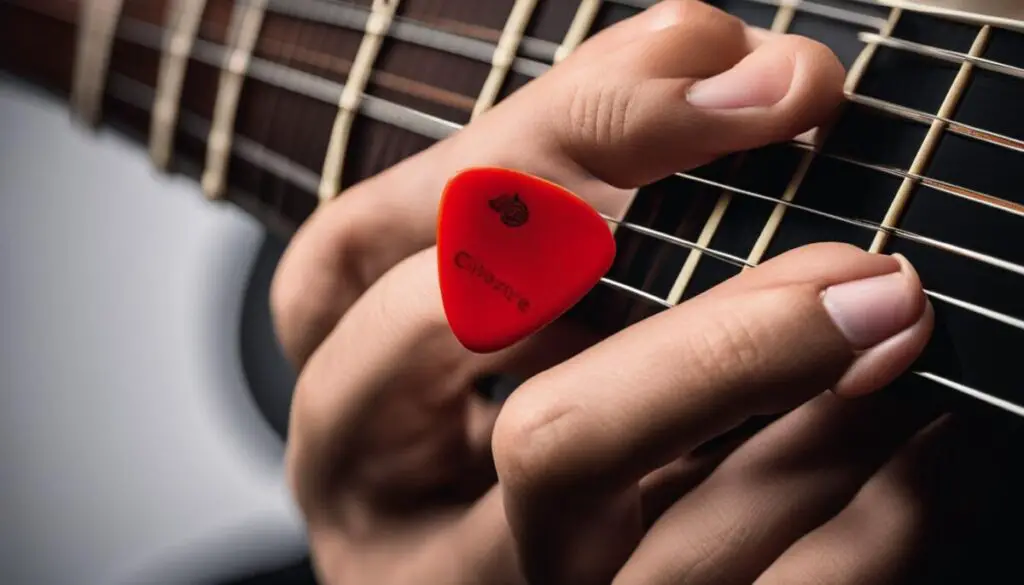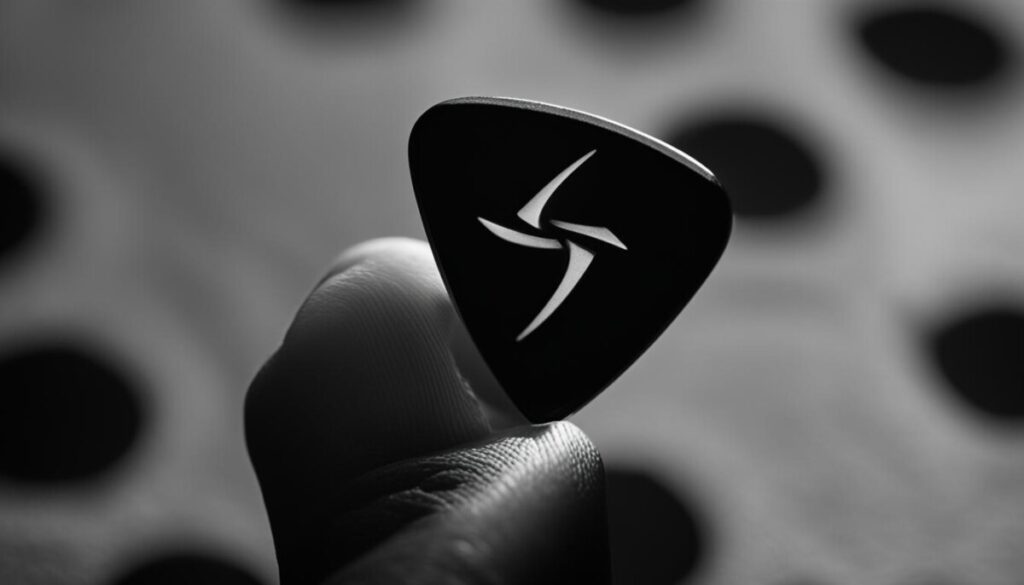Are you tired of your guitar pick slipping while you play? It can be frustrating and disrupt your performance. But fear not! There are practical solutions to improve your grip and prevent your pick from sliding.
If you’ve been wondering, “Why does my guitar pick keep slipping?” we’re here to help. In this article, we’ll explore the reasons behind pick slippage and provide you with effective solutions to keep it in place. Let’s dive in!
Key Takeaways
- Struggling with guitar pick slipping? You’re not alone!
- The type of pick you use can affect your grip. Experiment with different materials and thicknesses.
- Proper pick hold and technique are crucial for a firm grip. Cross your thumb over the back of the pick and use the side of your index finger to hold it.
- Strumming techniques, such as strumming at a 45-degree angle, can help prevent pick slippage.
- Pay attention to the direction and pointing of the pick. Position it slightly towards the bridge of the guitar for better control.
Types of Guitar Picks and Their Effect on Grip
The type of guitar pick you use plays a crucial role in your ability to maintain a solid grip while playing. Guitar picks are commonly made of plastic and come in various shapes and thicknesses. Understanding how different picks affect your grip can help you prevent the pick from sliding and improve your overall playing experience.
Thin picks are often favored by beginners as they are easier to control. However, they tend to be more floppy and prone to sliding. On the other hand, thicker picks offer more stability but may have a higher risk of slippage due to their rigidity. It’s essential to strike a balance between grip and flexibility that suits your playing style.
Consider experimenting with a variety of guitar picks to find the one that feels most comfortable in your hand and provides the right level of control. Trying picks of different shapes and thicknesses can significantly impact your grip and prevent the pick from sliding.
Comparative Table: Different Guitar Picks and Their Grip Characteristics
| Vendor | Material | Thickness | Shape | Grip Level |
|---|---|---|---|---|
| Fender | Celluloid | 0.7mm | Standard | Medium |
| Dunlop | Tortex | 0.88mm | Triangle | High |
| Ernie Ball | Delrin | 1.0mm | Teardrop | Medium-High |
This table provides an overview of different guitar picks from reputable vendors, their materials, thicknesses, shapes, and grip levels. It can be a useful reference to help you choose the right pick to enhance your grip and prevent slippage. Keep in mind that individual preferences may vary, and it’s worth trying out different options to find what works best for you.
Proper Pick Hold and Technique
Holding the pick correctly is essential for maintaining a firm grip. The recommended technique involves crossing your thumb over the back of the pick and using the side of your index finger to hold it. Make sure there is a little bit of plastic showing to ensure better control. Additionally, pay attention to the amount of pressure you’re applying while gripping the pick. Start with a gentle pinch that allows for comfortable strumming or picking without strain.
Strumming Techniques to Prevent Slippage
When troubleshooting the guitar pick slipping problem, it’s important to consider your strumming techniques. The way you strum can have a significant impact on the stability of your pick grip. By utilizing the following tips, you can fix a slippery guitar pick and improve your overall playing experience.
Aim for a 45 Degree Angle
Whether you’re using down strums or up strums, aim to strike the strings at a 45 degree angle. This angle provides optimal contact between the pick and the strings, reducing the chances of the pick sliding. Additionally, strumming at this angle allows for better control and precision in your playing.
Visualize Your Strumming Motion
To achieve the right forearm rotation and elbow movement, visualize your strumming motion as if you’re brushing the strings gently with a paintbrush or turning a doorknob. This gentle and fluid motion helps maintain a consistent grip on the pick, preventing it from slipping during your playing.

Practice maintaining this technique during your practice sessions. Start with slow and deliberate strumming, gradually increasing your speed as you build muscle memory and control.
By employing these strumming techniques, you can troubleshoot the guitar pick slipping problem and fix a slippery guitar pick. Remember to focus on maintaining a 45 degree angle when strumming and visualize your strumming motion for improved control. With practice and dedication, you’ll enhance your grip and enjoy uninterrupted playing.
Direction and Pointing of the Pick
The direction and pointing of the pick play a crucial role in preventing slippage. By adjusting the orientation of your pick, you can enhance its stability and maintain a secure grip. A simple yet effective technique is to aim to have the pointy part of the pick slightly towards the bridge of the guitar.
This positioning offers better leverage and control, reducing the chances of the pick sliding in the opposite direction. When the pick is oriented towards the bridge, the downward force exerted during strumming or picking helps anchor the pick in place.
During your playing sessions, pay close attention to the orientation of the pick and make any necessary adjustments to ensure a consistent grip. Regularly check the direction of the pick to avoid unintentional slipping and maintain optimal control over your playing.

Remember, a slight change in the direction of the pick can make a significant difference in its stability. Experiment with various angles and orientations to find what works best for you and your playing style. By mastering the correct pointing of the pick, you can overcome the challenge of slippage and enjoy a more confident and uninterrupted guitar playing experience.
Conclusion
Improving your guitar pick grip is essential for enhancing your playing experience and preventing pick slippage. By implementing proper techniques and experimenting with different picks, you can overcome this challenge and achieve better control. Remember to select the right pick that offers a balance between grip and flexibility for your playing style.
Mastering the correct pick hold and technique is a fundamental step in improving your grip. Ensure that you cross your thumb over the back of the pick and use the side of your index finger to hold it, allowing for better control. Applying the right amount of pressure while gripping the pick is also crucial for optimal performance.
Additionally, pay attention to your strumming technique, aiming to strum at a 45-degree angle. Visualize your strumming motion as if you’re gently brushing the strings with a paintbrush or turning a doorknob. This forearm rotation and elbow movement will help maintain stability and prevent pick slippage.
Furthermore, take note of the direction and pointing of the pick. Positioning the pointy part slightly towards the bridge of the guitar provides better leverage and control. Stay mindful of the orientation of the pick during your practice sessions, making adjustments as necessary to maintain a consistent grip.
With dedication and practice, you can improve your guitar pick grip and enjoy uninterrupted playing. Experiment with different techniques, picks, and positions to find what works best for you. Embrace the challenge of a slipping guitar pick, and keep strumming to the rhythm of your passion!
FAQ
Why does my guitar pick keep slipping?
There are a few reasons why your guitar pick may be slipping. It could be due to the type of pick you’re using, improper pick hold and technique, incorrect strumming techniques, or the direction and pointing of the pick. Luckily, there are solutions to address each of these issues.
What are some solutions for guitar pick slipping?
To improve your grip and prevent your guitar pick from slipping, you can try using different types of picks to find the right balance between grip and flexibility. It’s also important to hold the pick correctly by crossing your thumb over the back and using the side of your index finger. Practicing proper strumming techniques and paying attention to the direction and pointing of the pick can also help minimize slippage.
How can I improve my guitar pick grip?
Improving your guitar pick grip starts with finding the right pick that offers the right balance of grip and flexibility for your playing style. Holding the pick correctly, with your thumb over the back and your index finger on the side, can also enhance your grip. Additionally, practicing proper strumming techniques and maintaining the correct orientation of the pick can help you keep it in place.
What strumming techniques can help prevent pick slippage?
Strumming at a 45 degree angle, whether using down strums or up strums, can reduce pick slippage. Visualize your strumming motion as if you’re gently brushing the strings with a paintbrush or turning a doorknob to achieve the right forearm rotation and elbow movement. Practicing this technique will improve your strumming control and minimize pick slippage.
How does the direction and pointing of the pick affect its stability?
The direction and pointing of the pick can affect its stability. Aim to have the pointy part of the pick slightly towards the bridge of the guitar. This positioning offers better leverage and control, preventing the pick from sliding in the opposite direction. Pay attention to the orientation of the pick during your playing sessions and make adjustments if necessary to maintain a consistent grip.
How can I prevent my guitar pick from slipping?
To prevent your guitar pick from slipping, make sure to select a pick that offers a good balance between grip and flexibility. Hold the pick correctly by crossing your thumb over the back and using the side of your index finger. Practice proper strumming techniques at a 45 degree angle and pay attention to the pointing of the pick towards the bridge of the guitar. With these tips, you can keep your guitar pick in place and enjoy uninterrupted playing.

